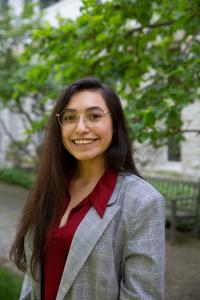You are here
Valeria Viteri-Pflucker
Illinois Wesleyan University
NIST Research Intern
National Institute of Standards and Technology (NIST)
Final presentation
![]() Valeria Viteri-Pflucker - Final Talk.pdf
Valeria Viteri-Pflucker - Final Talk.pdf
Gallium phosphide (GaP) is an indirect-bandgap semiconductor that is of interest for creating integrated nanophotonic devices. GaP can be used at very high powers for wavelengths above 900 nm due to its very low two-photon absorption coefficient β_2 in this regime, but precise knowledge of this as well as its optical Kerr coefficient n2 are not known. In our experiment, we use pump probe spectral interferometry to measure these coefficients as a function of wavelength. A pump pulse generates transient absorption and refractive index that is probed by a probe supercontinuum pulse. The probe is interfered with a reference beam, then measured in a spectrometer which lets us measure β_2 and n2. We normalize this data by using SiO2 as a reference material. We find reasonable agreement with a simple theoretical model and previous less precise measurements at a limited number of wavelengths.
Hello, my name is Valeria Viteri-Pflucker, and I am a recent graduate of Illinois Wesleyan University. I majored in physics and minored in mathematics, religion, and history, and plan on attending the University of Rochester this coming year to pursue a PhD in Optics. My most important involvement at my university has been the research I've been able to participate in. For my first two years, I conducted research with Professor Bruno deHarak studying laser-assisted free-free electron scattering and later, computationally simulating frustrated tunnel ionization in the presence of a strong femtosecond laser pulse. During my second and third years I participated in the Department of Energy's Summer Undergraduate Laboratory Internship (SULI) where I worked with Doctor Lin Zhou on understanding the nature of the skyrmion lattice by processing Lorentz Microscopy images of these magnetic quasiparticles. My senior year I've worked with Professor Tian-Xiao He on an Independent Study in mathematics to first understand introductory Wavelet Analysis, and next to do research into understanding the feasibility of generalizing data that wavelet analysis can be used on to include data that is not uniformly spaced.
During my time at Illinois Wesleyan University, I've also participated in a lot of extracurricular activities. I've been highly active in SPS. This year, my school's chapter of SPS and PME (honorary mathematics society) joined together to create a math and physics high school competition, of which I was the main coordinator. I also participate in SPIE (Society of Photo-Optical Instrumentation Engineers) where I help schedule and promote student research talks, and IEEE (Institute of Electrical and Electronics Engineers), of which I was President during this past year. In IEEE we have been building a pumpkin launcher that functions like a small scale rail gun that will be continued in the coming years. I'm also on the board of Lyrical Graffiti, a club that hosts monthly open mics and schedules to bring famous poets to my campus. I've also been a 4-year participant in IWU's School of Music, participating in Wind Ensemble, pep band, opera pit, and more.
Something that has really mattered to me for this summer is to be able to do hands-on research. The majority of my time at college has been during the COVID-19 pandemic, which means most of my research had to be computational. Before I start the next step in my journey, I want to experience in-lab experimental work to know how I fit into such an environment, and have been interested in working at NIST for years.

